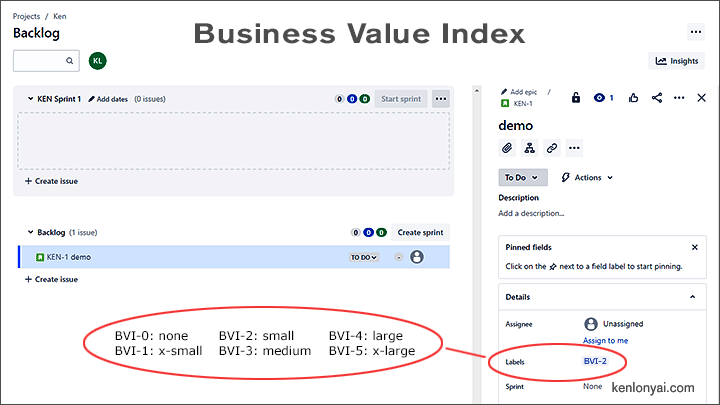
Business Value Index
0 – none
1 – tiny
2 –small
3 – medium
4 – large
5 – huge
The Business Value Index answers the question “How does this sprint contribute to the bottom line?”
It’s a mechanism to forecast and monitor the potential impact a sprint’s work has on the product and company, considering ROI and customer usage, so that business objectives can be tracked and evaluated more granularly and repeatedly, sprint by sprint.
Teams vary, companies and cultures vary, however, it’s not uncommon for a backlog to be prioritized by nearest term needs first. That sensible. Yet, examining those needs through the lens of direct benefit to company financials, DAUs or MAUs, and specific feature engagement can be neglected. It’s more typical to strive to get a chunk of work complete or a feature out the door and not particularly consider implications to near-term upsides and/or to wait and see if an expected benefit is realized.
The Business Value Index is a significant evolution to that basic thinking, where an expected sprint outcome is intended to be directly impactful and quantifiable. In that way, the business value at the conclusion of a sprint is anticipated and carefully planned for, during sprint planning.
The benefits include:
-
-
- Business outcome sprint planning from the lens of a near-term value-ad
- Reduction in variability of the selection of stories included in a sprint
- Close adherence to what can be described as a micro-roadmap
- Holding all involved to a mindset of outcome based delivery
- Closer engagement of engineering teams in product customer value
- A mechanism to limit the preventable accrual of technical debt
- Better tracking/reporting of the evolution and business impact of features and the product
-
A typical sprint is comprised of 4-8 user stories [but there can be more or less]. Also typical, is a point total between 21-30—dependent upon team capacity [# of resources and sprint duration] in that increment of potentially releasable work.
The goal of each sprint and ideally each story is to achieve at least a BVI-2 Business Value score, but higher clear is more desirable.
The intent is to show practical business value in every sprint and every PI or quarter.
A major impediment to achieving positive BVI is containing and managing technical debt. Most such debt has little net new business value except when it’s fixing code that detracts from user experience and user adoption. In fact, technical debt is a very costly drain to product development productivity and most often the antithesis of what Business Value intends to accomplish.
When used in conjunction with a PVR [Product Value Rationale] document, the series of BVI scores become significant data points to track the business interests of product development and deployment.
A Business Value Index can also be applied at the epic level. It takes longer to see the data and is still best used on sprints as well, but it can be considered another summary point for determining the progress of business and customer value.
Results over time are compared to past BVI predictions to measure how effective sprint [or epic] planning objectives meet up with results.
Some may be concerned that BVI scores are qualitative both when assigning scores and when evaluating results. However, that does not diminish their value. The process provides a better business mindset when planning work for a sprint and qualitative results are by no means less valuable than quantitative results in scenarios like this.
